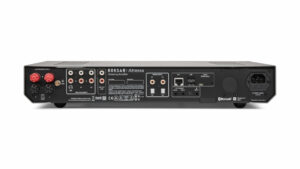
Rok’san Roll, Baby
Not long ago, the appeal of integrated amps was, shall we say, low. The segment had become “same old, same old,” lacking innovation and the latest features. Part of its decline in popularity was the lure of home theater, 4K streaming video, and multichannel, which moved buyers into the AV receiver/processor wing of electronics. But as the expression goes, what goes around comes around. Ultimately the high end found its way. Demographics were changing; empty nesters were downsizing into smaller homes, as well as smaller-footprint audio systems. The very definition of the integrated amplifier was also evolving. And once high-resolution streaming went from novelty to mainstream, a new segment of integrated was born. DACs, often bundled with network/streaming capability, found their way into the chassis. That, coupled with vinyl’s comeback and the explosion in personal listening, have made today’s integrated amps cooler and more practical than ever. They are one-box solutions like never before.
Which brings me to the Roksan Attessa streaming amplifier—an 80Wpc amp that fully embodies where today’s marketplace lives and, at $3199, is almost thrifty by today’s inflationary standards. Attessa is an all-new in-house design, Roksan’s first with integrated DAC plus network/streaming capability. Handsome but discreetly so, its low-slung front panel makes it an easy fit in even modestly sized dens. It features robust plate-steel and aluminum construction, and a machined anodized-aluminum front panel. A large circular volume/input control dominates the center of that front panel, where there are no obvious pushbuttons. For those who long for the old-timey, analog feel of knobs, toggles, and rocker switches, well, you’re out of luck. In their place is an illuminated, horizontal, orange LED strip (reminiscent of a MacBook Pro’s touchbar) that runs across the center of the panel and indicates input sources on the left and volume increments on the right. Personally, given a choice, I’d have preferred an illuminated numerical scale to indicate volume rather than a fader-style graphic, but I’m probably in the minority. At the right end of the facia is a 3.5mm stereo mini-jack headphone socket, whose 7.5Vrms output is suitable for all but the most finicky headgear.
Stepping around to the back panel, there’s a sufficient variety of digital and analog connections, with two optical and two coaxial digital inputs, provisions for two USB thumb drives, a pair of analog inputs, plus a moving-magnet phonostage. The phono setting is a standard 47k ohm/56pf, and there are three gain settings to accommodate cartridges with outputs from 3–12mV. The in-house designed DAC section resolves to 24-bit/192kHz for the coax inputs and 24-bit/96kHz for optical. The SPDIF inputs will decode MQA-encoded PCM streams, including MQA CDs played back by the optional companion Attessa CD transport. It supports most of the familiar high-res streaming-audio formats and services.
Embrace the App
Setup was just a free and downloadable app away—in this case, MaestroUnite, a set-up app that partners with Roksan’s other components, connects to the local Wi-Fi network, and allows the owner to configure the amp with its companion CD transport to operate as a single unit. Further, there’s on-the-fly control of Roksan’s built-in features like input configuration, headphone sensitivity, analog input gain, balance, and low-power standby (as well as over-the-air updates).
For day-to-day use the recommended smartphone-based, BluOS controller app was, indeed, the way to go, especially if you do a lot of streaming from any one of the major high-resolution streaming services. (I’m looking at you Tidal and Qobuz.) That includes a shared music library, USB drives, Internet radio stations, and podcasts. It’s an easy app to navigate, and fairly intuitive after a few minutes of familiarization. Guided by its graphical interface and haptic feedback, selecting my listening volume and input source soon became second nature. Conveniently, there are three BluOS presets directly available from the inputs list for easy accessibility. As a streaming jukebox, the BluOS app was more than up to the task. However, I was still glad to have the handheld remote control near at hand for common functions like raising or lowering volume and mute.
In an amplifier segment where three-figure power ratings are more often the norm, Attessa’s 80Wpc rating is not an especially high number. But tell that to my 83dB sensitive ATC SCM20s. They couldn’t have been happier being driven by Attessa. Believe me, they are known to get a bit cranky when not fed sufficient high-quality power. But wattage ratings, as many of us know, are really only part of the story. Amps with significantly higher ratings than Attessa will not necessarily sound better or even as good—they only “read” more powerful on the page. Like the line goes, not all watts are created equal.

This is all a roundabout way of saying that Attessa is one rocking amp with high capabilities. Throughout this evaluation it was a fully formed performer and a glitch-free workhorse in my system, with no new-amp “teething” problems to speak of, especially commendable in a freshly minted design. In sonic performance, it registered high scores across all genres of music with most every recording it encountered. It was grain-free and non-edgy and wasn’t apt to shade or spotlight particular frequency bands or overcook harmonics or treble information. Baritone or soprano, each sounded exactly the way nature intended. It maintained a ripe and natural midrange, a firm and controlled bass, and a smooth if slightly drier treble. I wouldn’t characterize the sound of Attessa as laid-back, nor was it overly cool or clinical. There was a spotless clarity to every note. Listen to Mary Travers’ wistful vocal during “500 Miles” from PP&M’s eponymous album Peter, Paul & Mary, and you’ll know what I mean. There was orchestral warmth, sometimes in abundance, but only when it was present on the recording. I’m particularly sensitive to the presence of low-level noise clinging like contrails to delicate and decaying piano notes and harmonics. Attessa was remarkably free of this artifact. What it couldn’t fully convey was the rosy blush of harmonic detail and air of an upper tier, tube-hybrid integrated like Aesthetix’s Mimas.
The Attessa was especially impressive imparting dynamic energy in both the macro and micro senses; transient information never grew weak-kneed in the face of large dynamic swings. A less noteworthy amp will flatten and smooth these transitions, as if acting like a recording-studio compressor and limiter. This doesn’t happen in the acoustic of the concert hall; every instrument from the triangle to the tuba is reproduced in full voice, as it should be.
Given that my LP rig was “offline” for most of this evaluation period due to a factory restoration of my SME Series V tonearm, I didn’t have a much time to spend with the Attessa’s phonostage input, but the time I did spend was more than worthwhile. It has selectable gain and performed quietly and with balance and conviction. The Clearaudio Charisma V2 I was using has a fairly easing going 3.6mV output, so noise was not a problem. But the familiar Charisma sound was reproduced in abundance. On a track like “Someone in a Tree” from Stephen Sondheim’s Pacific Overtures, there were the familiar hints of warmth, zero etch or grain, and superior imaging and placement of the singers arrayed across the stage. Channel separation was very good, too. Imaging was not especially dimensional, however. On a track like Rutter’s “Lux Aeterna,” there’s not a lot of depth on the soprano, and the depth and acoustic of the hall seemed a bit shortened—a generalized soundstage compared with a top-notch reference integrated like the Aesthetix.
For digital performance, I threw one Tidal playlist after another at the Attessa, waiting to trip it up, to find its weakness. I even sent the digital signal from my dCS Puccini to let the Attessa’s DAC take the reins. That trip-up never happened. The Roksan’s DAC section is uh, Rok-solid. Comparing my reference Lumin S1 media player to the Attessa DAC, there was little in the way of a sonic letdown. The Lumin owned the soundstage and three-dimensionality from the outset. Its warmer, analog-like character contrasted with Attessa’s drier, less airy personality. But when it came down to imaging precision, tonal balance, and textural complexity, the contest was a lot closer. With the Lumin more than triple the price of an entire Attessa kaboodle, this close competition should make any Roksan owner satisfied with a savvy buying decision.
An interesting side note. Roksan was founded in 1985 and acquired by British loudspeaker manufacturer Monitor Audio Ltd in 2016. The Attessa Series components are post-acquisition developments, and Roksan has stated that it will be revising and refining current products and developing new products. These developments, along with Monitor Audio’s fine reputation in loudspeakers, should augur well for forthcoming system-wide synergy that audiophiles can truly look forward to. Indeed, the Roksan Attessa turned out to be a real sleeper. Looks, ergonomics, and performance—a lot of pieces must fall into place to successfully bring together digital and analog sections, sophisticated software, plus Wi-Fi and network capability. It’s no small task, but with Attessa Roksan has fully met the challenge and then some. At $3199 all-in, the Attessa is likely the one to beat in a hotly competitive division. Highly recommended.
Specs & Pricing
Power: 80Wpc into 8 ohms, 130Wpc into 4 ohms
Digital inputs: 2 optical, up to 96kHz/24bit; 2 coax SPDIF up to 32-bit/192kHz
Analog inputs: 2 RCA, MM phono
Outputs: 1pr RCA analogue (Pre-out/SUB)
Supported audio formats: MP3, AAC, WMA, OGG, WMA-L, ALAC, OPUS
MQA, FLAC, WAV, AIFF, Supports converted DSD playback via the BluOS desktop app (only) up to 24 bit/192kHz
Dimensions: 17** x 3** x 14.75**
Weight: 23 lbs.
Price: $3199
KEVRO INTERNATIONAL
902 McKay Road, Unit #4
Pickering, ON L1W 3X8
(800) 667-6065
kevro.com

By Neil Gader
My love of music largely predates my enthusiasm for audio. I grew up Los Angeles in a house where music was constantly playing on the stereo (Altecs, if you’re interested). It ranged from my mom listening to hit Broadway musicals to my sister’s early Bob Dylan, Joan Baez, Beatles, and Stones LPs, and dad’s constant companions, Frank Sinatra and Tony Bennett. With the British Invasion, I immediately picked up a guitar and took piano lessons and have been playing ever since. Following graduation from UCLA I became a writing member of the Lehman Engel’s BMI Musical Theater Workshops in New York–working in advertising to pay the bills. I’ve co-written bunches of songs, some published, some recorded. In 1995 I co-produced an award-winning short fiction movie that did well on the international film-festival circuit. I was introduced to Harry Pearson in the early 70s by a mutual friend. At that time Harry was still working full-time for Long Island’s Newsday even as he was writing Issue 1 of TAS during his off hours. We struck up a decades-long friendship that ultimately turned into a writing gig that has proved both stimulating and rewarding. In terms of music reproduction, I find myself listening more than ever for the “little” things. Low-level resolving power, dynamic gradients, shadings, timbral color and contrasts. Listening to a lot of vocals and solo piano has always helped me recalibrate and nail down what I’m hearing. Tonal neutrality and presence are important to me but small deviations are not disqualifying. But I am quite sensitive to treble over-reach, and find dry, hyper-detailed systems intriguing but inauthentic compared with the concert-going experience. For me, true musicality conveys the cozy warmth of a room with a fireplace not the icy cold of an igloo. Currently I split my time between Santa Fe, New Mexico and Studio City, California with my wife Judi Dickerson, an acting, voice, and dialect coach, along with border collies Ivy and Alfie.
More articles from this editorRead Next From Review
See all
Oswalds Mill Audio K3 Turntable
- Apr 12, 2024

2023 Golden Ear: Schiit Freya S Preamplifier
- Apr 12, 2024




















